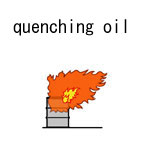| Case Name |
Fire caused due to contact with hot sludge during cleaning a quenching oil bath |
| Pictograph |

|
| Date |
May 2, 1989 |
| Place |
Yashio, Saitama, Japan |
| Location |
Metal Products Factory |
| Overview |
Operation of the gas carburizing continuous heat treatment furnace stopped on April 29th, 1989, because the quenching oil bath at the outlet of the quench hardening furnace should be cleaned once a year. On May 2nd, drawing off of quenching oil from the bath was completed, and an operator entered the quenching oil bath. He began to work to remove sludge scale at the bottom of the bath. Just before the work was completed, a large lump of sludge scale, which adhered to the chute, fell into the bath, and adhered quenching oil caught fire. The operating temperature of the quench hardening furnace was 880 °C, and the temperature of the chute was still 300 °C when the scale fell. |
| Incident |
At a factory where quenching of screws was done using a gas carburizing furnace and a quenching oil bath, removal of sludge scale in the quenching oil bath was performed once a year. While the quenching oil bath was being cleaned, a large lump of sludge scale fell into the bath from a chute and caught fire. Refer to Fig2.
Sludge scale: material comprising iron powder and quenching oil adhering to each other. |
| Processing |
Consumption and usage |
| Substance |
Quenching oil |
| Type of Accident |
Fire |
| Sequence |
In the afternoon on April 29th, 1989; the operation of the quenching oil bath stopped, and temperature-lowering work started.
About 08:00 on May 1st; cleaning work in the bath started.
On May 2nd; removal of oil was completed and operators entered the oil bath. Work to remove scale started in the quenching oil bath. Just before completing work, a large lump of sludge scale fell from a chute above, adhering oil residues in the oil bath ignited, and a fire occurred. |
| Cause |
The quench hardening furnace temperature was 880°C during usual operation. The furnace was stopped for the cleaning work from the afternoon on April 29th, but the furnace temperature was still high (about 300 °C at the time of the accident), and the temperature at the chute was also high. The sludge scale that adhered to the inside of the chute was also hot, and the sludge ignited quenching oil adhering to the quenching oil bath. |
| Countermeasures |
1. The following are taught to workers: Quenching oil might also ignite even if its flashpoint is high; moreover, it is difficult to extinguish an oil fire because of the high temperature of the oil.
2. A separation device should be installed between the chute and the bath to prevent lumps of sludge from falling. If it is difficult to install, the operation manual should be revised so that oil in the bath would not removed until the temperature lowers sufficiently. |
| Knowledge Comment |
Quenching oil, which has a flash point over 250 °C, was deleted from the list of dangerous materials. It means the danger of quenching oil seems to have been considered to be small. However, quenching oil fires occur often. When ignited, it is difficult to extinguish quenching oil because the temperature is high. |
| Background |
It is supposed that during usual operation, substances with a much higher temperature were treated and the oil did not ignite. Therefore, it was believed that even if substances at 300 °C fell into the quenching oil bath, the oil would not ignite, although the quantity of oil was too small to cool a hot substance.
It is necessary to revise the operation manual for cleaning so that a separating device should be installed between the chute and oil bath or oil in the bath should not be removed until the temperature of the furnace and the chute lowers sufficiently. |
| Incidental Discussion |
Quenching oil seemed to be safe in terms of fire because the oil made contact with high-temperature objects in normal use. But, as quenching oil is also a hydrocarbon, fires may occur due to mishandling of quenching oil. |
| Reason for Adding to DB |
Example of fire of quenching oil fire caused due to contact with hot sludge |
| Scenario |
| Primary Scenario
|
Organizational Problems, Poor Management, Habit, Poor Value Perception, Poor Safety Awareness, Inadequate Risk Recognition, Misjudgment, Misjudgment of Situation, Planning and Design, Poor Planning, Poor Planning of Repair, Regular Movement, Dangerous Movement, Going into during Dangeroud Condition, Bad Event, Chemical Phenomenon, Very Easy Condition to be Oxidized, Secondary Damage, External Damage, Fire
|
|
| Sources |
Fire and Disaster Management Agency, Major cases of accidents, Fire during cleaning quenching oil bath. Accident cases of dangerous materials. pp.31, 22-223.
|
| Physical Damage |
The roof and the internal wall of 890 square meters became sooty by fire. The main body of a heat-treating furnace and accessories were partially destroyed by fire. |
| Financial Cost |
¥15 million (Accident cases of dangerous materials) |
| Multimedia Files |
Fig2.Sketch of the hardening facility
|
| Field |
Chemicals and Plants
|
| Author |
KOSEKI, Hirosi (National Research Institute of Fire and Disaster)
TAMURA, Masamitsu (Center for Risk Management and Safety Sciences, Yokohama National University)
|
|